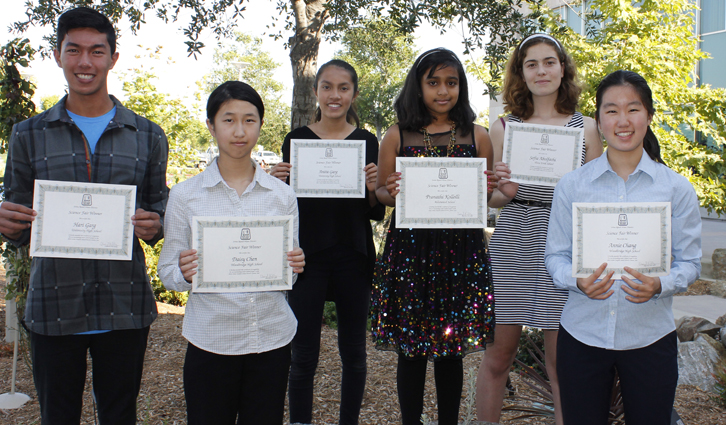-
Published: Jun 09, 2015 | 09:00 AM
IRWD Board Honors Science Fair Winners
Six Irvine Unified School District students were honored at the June 8 Board meeting for their water-related science fair projects.
The students were presented with certificates and each of their schools will receive $100 on their behalf for science programs, with an additional $100 going to support the district science fair.
IRWD has supported the science fair since its inception. In the fall, IRWD professionals participte in Ask-a-Scientist Night, which offers the students the opportunity to get their questions answered about their prospective projects.
This year’s science fair was held at Irvine High School. IRWD Water Quality experts Mindy Bergen and Jacob Broderick judged more than 60 water-related projects based on the use of the scientifiv method, creativity, relevance, completeness of the project and evidence of problem solving.
This year’s winners:
- Pranathi Kollolli, 6th grade – “Solar-Powered Water Desalination.” This project combined Pranashi’s interest in solar energy and how it effects everyday life and desalination as a method to provide fresh water during the drought. She wanted to find out if solar energy could be used in the process of desalination. After conferring with someone from IRWD, she decided to construct her own solar desalination plant. She hypothesized that higher temperatures will result in more desalinated water. She noticed at the end of her experiment that the amount of desalinated water differed depending on the color her collection containers were wrapped in and the shape of the containers themselves. She also noticed that the experiment didn’t yield full potential once the sun went down. The project went to the county competition, where it was recognized with a special award from the Orange County Water district and the Coastal Science Award for excellence in coastal science and engineering.
- Sofia Abolfathi – 8th grade – “Seawater can be used to replenish inland aquifers.” Sofia wanted to find out if ocean water could be used to replenish inland aquifers in hopes of battling the drought by creating a new source of water. Sofia received assistance from IRWD Regulatory Compliance Manager Lyndy Lewis, who reviewed the feasibility of the experiment. Using equal amounts of charcoal, sand and clay, Sofia filtered 1.5 liters of saline solutions. The experiment was performed in 15 trials. Her conclusion was that inland aquifers could be replenished using sea water. Her experiment showed that charcoal-filtered water had the lowest salinity. Sofia’s project won a second place at the District level and she went onto the county competition, where she was invited to the Broadcom Masters event.
- Annie Chang and Daisy Chen – 10th grade – “Multimethod analysis and spatial modeling of bacterials dynamics in Newport Bay.” Annie and Daisy were interested in finding out how much bacterial levels varied by location and if levels varied in response to environmental factors. Their project attemped to identify trends in coliform and enterococcus bacteria levels throughout Newport Bay and the Newport Beach Coastline. They conducted field water sampling at multiple locations last July and August and this past February. Their results generally confirmed their sources of bacterial input, with some exceptions. Their project continued to the county competition in April, where they took a first place, then on to the state competition, where they received fourth place.
- Hari Garg, 11th grade, and Anita Garg – 9th grade, University High School – “Pathogen detection in Southern California Water Using a particle counter.” This brother and sister team collaborated to determine the water quality of various commonly visited Southern California water sites using a device called a particle counter. They hypothesized that a marsh located near the Newport Back Bay would contain the highest number of pathogens and that the particle counter would be able to measure the number of bacteria in water at ultra-low concentrations. They took water samples from seven different locations and used the particle counter to measure bacteria. The hypothesis that the marsh would contain the highest concentration of bacteria was incorrect, it had the second highest, with golf course runoff having the highest. They were correct in their hypothesis that the particle counter could detect bacteria in ultra-low concentrations. The project went to the county competition, where it took a third place award. It then went on to the state competition.
Learn more about IRWD’s education programs on our website.



